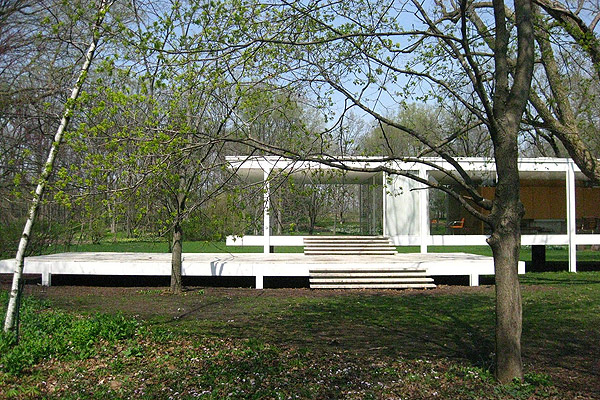
* Blair Kamin asked architect Dirk Lohan—grandson of Mies, designer of the McDonald's campus—for his notes from a recent lecture on his grandfather's Tugendhat House and Farnsworth House. It's a fascinating look into the mind of an architect, and how he thinks about space:
[T]he concept of the Farnsworth House, a country retreat from the big city, has been elevated to such spiritual abstraction that it demands complete acceptance of its inner logic from the occupant. So unconventional is the house that every move and every activity in it assume an aesthetic quality which challenges behavior patterns formed in different surroundings.
* Lohan was the subject of a lengthy, wonderful Chicago piece by Robert Sharoff, "Field of Pain," for his controversial redesign of Soldier Field:
To some degree, Lohan believes that he is the victim of a conservative, retrograde movement in Chicago and in the country generally. "There is this feeling that old things are good things and that the new and the novel are scary," he says. "I'm turned on by modern, new, innovative things. The issue of how to modernize in a functional way an old building is an eternal architectural question. I'm sure that when they started building Gothic additions to Romanesque cathedrals in the Middle Ages, there were people who said, ‘My God, they're ruining everything.'"
* Speaking of lectures, Lynn Becker brings the news that British genius Thomas Heatherwick is lecturing at IIT on Thursday. In 2010, Edward Lifson talked with Heatherwick about his spectacular, unreal Seed Cathedral, designed for the Chinese equivalent of the Columbian Exposition:
But we were deliberately playing with the contrast between grandiosity and insignificance, bundling these things together. In a way, the power of the potential in those sixty thousand seeds is mind-blowingly massive. And you’re standing in the middle of the most bio-diverse point you could possibly stand in, in Shanghai! Everything is there, and yet there’s a kind of absence, it’s totally calm. We have even had people say, ‘Where is it? There’s nothing here!’
* The plans for Navy Pier's redesign go up for display at the end of the month. Navy Pier never ceases to amaze me—with some exceptions, like the stained-glass museum and Chicago Shakespeare Theater, my first impression was that it was a very expensive, sanitized flea-market mall. Yet during the summer, the Grand bus always fills up at Grand and Halsted with tourists going from the Blue Line to Navy Pier. Its persistence as a tourist destination despite its essential unremarkableness is pretty amazing to me, so it'll be interesting to see what the visions for the future of it are like.
* Megan Cottrell talks to Tom Feltner of the Woodstock Institute about the possibility of turning foreclosed homes into rentals en masse.
* Blueprint: Chicago looks at the old Sears, Roebuck headquarters in North Lawndale—the company's move to the Sears Tower followed the late-60s violence that devastated the neighborhood.
* A Chicago Sojourn has a post about how the city is considering buying and tearing down the Crain & Morlan building in Clearing to increase the runway buffer zone around Midway, an effort that goes back to the 2005 tragedy where a jet overran the runway, and the airport, killing a six-year-old.
Photograph: andrewzahn (CC by 2.0)


